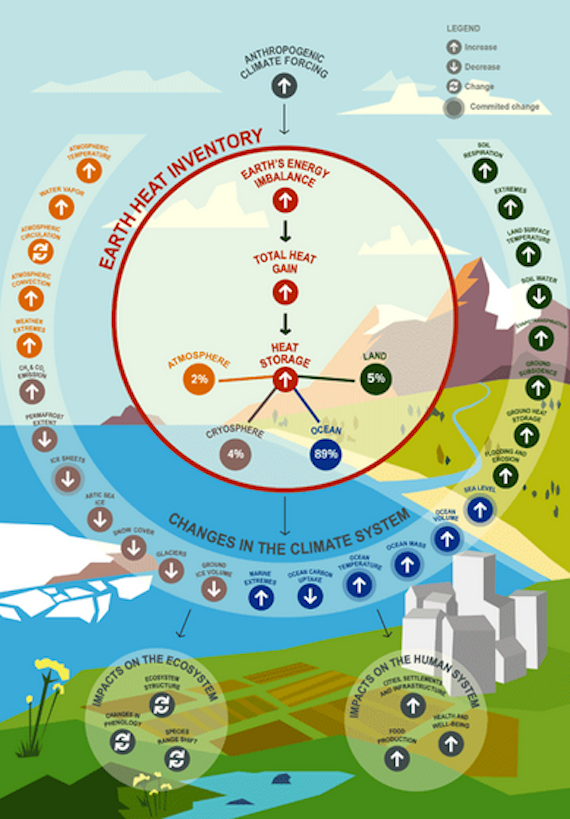Ann Arbor (Informed Comment) – The oceans are hot. They are hot in a way that surprises and distresses climate scientists, Everyone knew they would heat up because of the climate emergency. But no one thought it would happen this fast and with this intensity. Moreover, some of the side effects we are seeing, like less oxygen in the oceans, are positively frightening.
That is the conclusion of a paper published last week by Karina von Schuckmann et al., “Heat stored in the Earth system 1960–2020: where does the energy go?” in Earth System Science Data.
Because we have been burning gasoline to run our cars and burning gas and coal to heat our homes and office buildings, we have been putting tens of billions of tons of carbon dioxide into the atmosphere for decades, and have been spewing extra CO2 in some quantity since the Industrial Revolution began around 1750. Carbon dioxide is a heat-trapping gas. Earth is heated by sun rays, but a lot of the heat they brought to the earth used to dissipate right back into outer space through our oxygen-nitrogen atmosphere that only had 280 parts per million of carbon dioxide. Now, we are averaging 417 ppm of CO2, and the planet has heated up significantly, by nearly 2 degrees F., in the past little over a century.
Where has all that extra heat gone? Well, 87% of it has gone into the oceans. They will also absorb the carbon dioxide itself, making them much more acidic. The authors point out that ocean heating is a good proxy for global heating and the effects of the climate emergency in general.
The authors observe, “The long atmospheric lifetime of carbon dioxide means that [extra heating and its effects] will remain positive for centuries, even with substantial reductions in greenhouse gas emissions, and lead to substantial sea-level rise, ocean warming, and ice shelf loss.”
Most of the heat that has gone into the ocean is stored in the 2100 feet closest to the surface, though the next level down is also heating up. In fact, recent research has shown that some heat waves reach all the way to the floor of the ocean.
Von Schuckmann and her colleagues looked at heat gain in the atmosphere above the oceans and found that it is accelerating, with recent decades heating up much more quickly than the average since 1971. In 2006-2023 there was a big increase in the rate of heating.

K. von Schuckmann et al.: Heat stored in the Earth system 1960–2020 1679 Figure 1. Schematic overview on the central role of the Earth heat inventory and its linkage to anthropogenic emissions, the Earth energy imbalance, change in the Earth system, and implications for ecosystems and human systems. The Earth heat inventory plays a central role for climate change monitoring as it provides information on the absolute value of the Earth energy imbalance, the total Earth system heat gain, and how much and where heat is stored in the different Earth system components. Examples of associated global-scale changes in the Earth system as assessed in Gulev et al. (2021) are drawn, together with major implications for the ecosystem and human systems (IPCC, 2022b). Upward arrows indicate increasing change, downward arrows indicate decreasing change, and turning arrows indicate change in both directions. The percentages for heat stored in the Earth system components are provided over the period 2006–2020 (see Sect. 6).
The rate of sea level rise varies from place to place, but overall it has doubled since the 1990s. Back then, the seas were rising about 2.3 millimeters a year, but in 2013-2023 it is 4.6 mm annually.
Just this month, April 2023, ocean surface temperatures spiked to a new high, leaving scientists scratching their heads. In the first week of April, the average was nearly 70 degrees F. (21.1 C.), which is the highest average temperature recorded since record-keeping began in the late 19th century.
Hot ocean surface water, and hot levels below that, are bad for many reasons. Hot water takes up more space than cold water, which contributes to sea level rise. The hot ocean surface waters provide the energy to drive hurricanes and cyclones, making them more intense. Warmer water has more water vapor in the air above it, so those massive storm systems cause heavier precipitation and flooding. The extra evaporation and water vapor also contributes to further global heating, since water vapor is a greenhouse gas that keeps heat from radiating into space. Hot ocean water also helps melt ice in places like Greenland and Antarctica. Land ice that melts runs into the oceans and that raises their level, threatening low-lying cities and plains. The hot ocean water develops oxygen deserts, causing dead zones. Some marine life can’t survive a sudden increase in temperature, and if this phenomenon continues we could see a mass die-off. Some 10% of humanity depends on fishing for its nutrition.
For these reasons, the new scientific findings are highly alarming.


 © 2025 All Rights Reserved
© 2025 All Rights Reserved